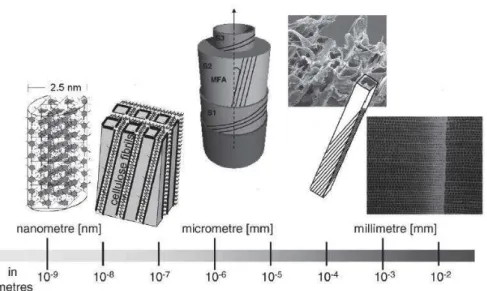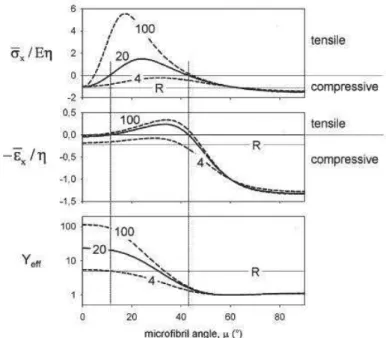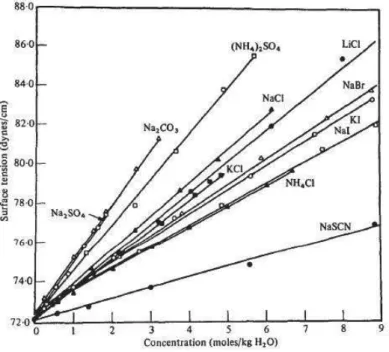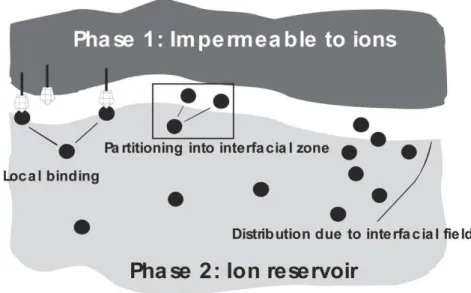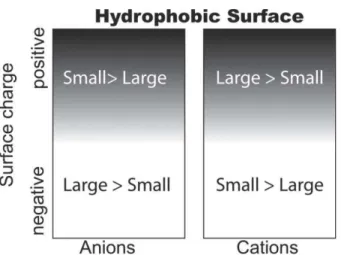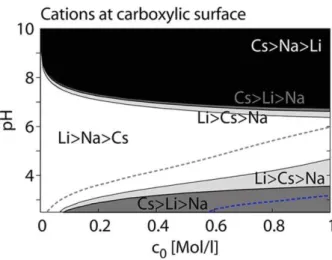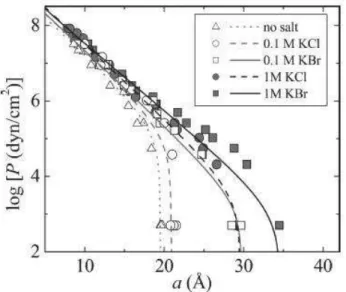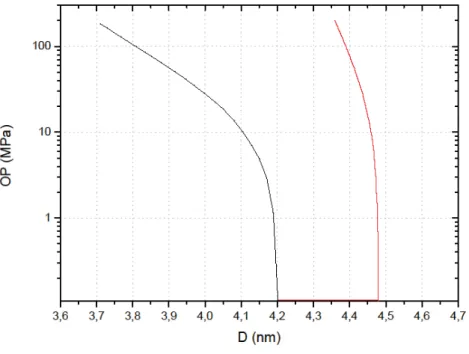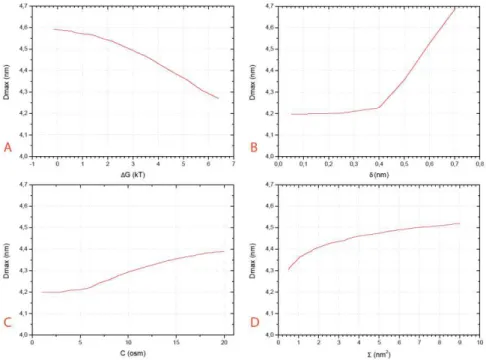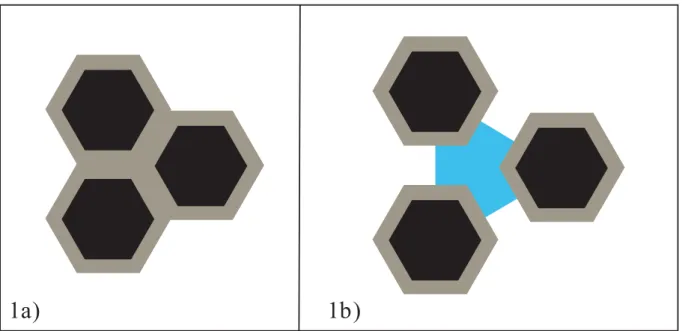HAL Id: tel-01845606
https://tel.archives-ouvertes.fr/tel-01845606
Submitted on 20 Jul 2018HAL is a multi-disciplinary open access archive for the deposit and dissemination of sci-entific research documents, whether they are pub-lished or not. The documents may come from teaching and research institutions in France or abroad, or from public or private research centers.
L’archive ouverte pluridisciplinaire HAL, est destinée au dépôt et à la diffusion de documents scientifiques de niveau recherche, publiés ou non, émanant des établissements d’enseignement et de recherche français ou étrangers, des laboratoires publics ou privés.
Thermodynamics of water adsorption in model
structured molecular systems including analogues of
hemicelluloses, crystalline cellulose and lignin
Aurelio Barbetta
To cite this version:
Aurelio Barbetta. Thermodynamics of water adsorption in model structured molecular systems in-cluding analogues of hemicelluloses, crystalline cellulose and lignin. Other. Université Montpellier; Universität Potsdam, 2017. English. �NNT : 2017MONTT171�. �tel-01845606�
THÈSE POUR OBTENIR LE GRADE DE DOCTEUR
DE L’UNIVERSITÉ DE MONTPELLIER
En Chimie et Physico-Chimie des Matériaux École doctorale Sciences Chimiques Balard - ED 459
Unité de recherche UMR 5257 - ICSM - Institut de Chimie Séparative de Marcoule
Présentée par Aurelio BARBETTA
Le 20 Novembre 2017
Sous la direction de Thomas ZEMB
et Helmuth MÖHWALD
Devant le jury composé de
M. Thomas ZEMB, Professeur, ICSM Marcoule
M. Helmuth MÖHWALD, Professeur, Max Planck Institute of Colloids and Interfaces M. Francesco DI RENZO, Directeur de recherche, ENSCM
Mme Anne-Karine FROMENT, Ingénieur, Aro-nucleart
M. Emanuel SCHNECK, Group Leader, Max Planck Institute of Colloids and Interfaces M.Luca BERTINETTI, Group Leader, Max Planck Institute of Colloids and Interfaces
Directeur de these CoDirecteur de these Examinateur Rapporteur Rapporteur Invité
Thermodynam ics of water adsorption in model structured
molecular systems including analogues of hem icelluloses,
1
THERMODYNAMICS OF WATER ADSORPTION IN
MODEL STRUCTURED MOLECULAR SYSTEMS
INCLUDING ANALOGUES OF HEMICELLULOSES,
CRYSTALLINE CELLULOSE AND LIGNIN.
PRESENTED BY AURELIO BARBETTA
Delivered by UNIVERSITE de MONTPELLIER
and the Institute of Chemistry - University of Potsdam
In the researcher units of ICSM Marcoule
and Max Planck Institute of Colloids and Interface
within the frameworks of L.I.A. Recycling CNRS-MPG
3 Abstract
Wood is a complex and hierarchically organized material. It is characterized by an architecture of stiff crystalline cellulose fibrils, parallel to each other, and surrounded by a soft matrix made of hemicelluloses, lignin and water. When adsorbing water, the matrix swells and provides a source of internal stress for the stiff cellulose fibre, which are winding with a spiral angle around a central lumen. According to this angle, the material exhibit a wide range of behaviors and mechanical properties, being able to act as a stiff material to bear load, or shrink or expand.
Results of theoretical calculations on all the forces playing a role during water adsorption bring to the formulation of an Equation of State, that considers entropic, chemical, colloidal and mechanical terms to predict with an analytical expression the water absorption of untreated wood as a function of humidity changes.
The aim of the thesis is to extend the equation of state to the case of wood treated with electrolytes. The experimental part is performed using specific sorption devices as well as X-Ray scattering techniques. The theoretical part is developed extending the established master equation linking molecular level chemical forces, colloidal interactions and mechanics. The results of the model are tested against experimental data of electrolytes adsorption and compared with their chaotropic/kosmotropic character according to the Hofmeister series, which classifies ions according to their hydration properties.
Nowadays, several wood treatments have been developed to reduce the water uptake by wood, in order to confer higher resistance to moist to low-quality wood materials. The final aim of the project is to test the prediction of the model against these known treatments and to develop a general model to describe the behaviour of the wood under different chemical and physical environments. This way, new treatments can be conceptually designed and pre-existing treatments (as for instance the patented "woodprotect" one) improved.
4 Resume
Le bois est un matériau nanocomposite complex, fortement anisotrope et hiérarchiquement organisé. La micro-structure à l'échelle nanométrique est caractérisée par des nanofibres rigides de cellulose cristalline parallèles les unes aux autres et noyées dans un matrice plus molle et moins anisotrope. Cette matrice est composée par hémicelluloses et lignine, avec une absorption contrôlée par l'entropie et les liasons hydrogène entre hémicelluloses, lignine, et la surface de micro-cristaux de cellulose. La matrice est hygroscopique et se gonfle avec les changements de l'humidité relative, en fournissant une source de stress interne, tandis que les fibrilles de cellulose s'enroulent en spirale autour de la lumière centrale à un angle précis, qui est appellè AMF, angle des micro-fibrilles. Les micro-fibrilles se réorganisent passivement selone les contraintes osmotique appliquéees. Selon l'AMF, le positionnement et les propriétés mécaniques des fibres de bois varient considérablement: le matériau rigide se rétrécit ou il s'alloonge dans le sens de la longeur lors du gonflement, en générant de cette façon une grande déformation anisotrope. Une première forme d'équation d'état comprenant entropie et termes chimiques, colloïdaux (comme la force d'hydratation) et termes mécaniques macroscopiques a été établie et permet de prédire sans paramétres l'absorption d'eau en fonction de l'humidité relative du composite de bois pas traité.
Le but de la thèse est d'étendre cette équation d'état au bois traité par absorption d'électrolytes en conditions hydrotermales, en intégrant l'équation avec des termes chimiques lié à la presence d'électrolytes. Les résultats du modéle sont comparés avec les données experimentales de sorption d'électrolytes formulés en fonction de la balance entr chaotropes et kosmotropes de l'échelle de Hofmeister. Les données expérimentales sont produit à partir des isothermes de sorption et des mécanismes moteurs pour tester la prédiction de la théorie en explorant l'effet du soluté (introduit dans le bois par mise en équilibre avec une solution utilisée comme une réservoir osmotique) sur la structure et les dimensions du materiau.
5 Zusammenfassung
Holz ist ein komplexes, hoch anisotropes und hierarchisch organisiertes Nanokompositmaterial. Die nanoskalige Mikrostruktur zeichnet sich durch starre, parallele, kristalline Cellulose-Nanofasern aus, die in eine weichere, weniger anisotrope Matrix eingebettet sind. Diese Matrix besteht aus Hemizellulosen und Lignin, mit kontrollierter Absorption durch Entropie und Wasserstoffbrücken zwischen Hemizellulosen, Lignin und der Oberfläche von Cellulose-Mikrokristallen. Die Matrix ist hygroskopisch und quillt mit Veränderungen der relativen Luftfeuchtigkeit auf, wodurch ein innerer Stressfaktor entsteht, während Zellulosefibrillen sich in einem präzisen Winkel um das zentrale Licht winden, der als AMF bezeichnet wird. Die Mikrofibrillen reorganisieren sich passiv zu den osmotischen Zwängen. Je nach AMF variieren die Positionier- und mechanischen Eigenschaften der Holzfasern erheblich: Das starre Material schwindet oder legiert sich beim Quellen in Längsrichtung und erzeugt so eine große anisotrope Verformung.
Eine erste Zustandsgleichungsform, die Entropie und chemische, kolloidale (wie z. B. Hydratationskraft) und makroskopische mechanische Begriffe umfasst, wurde etabliert und erlaubt die Vorhersage der Wasseraufnahme in Abhängigkeit von der relativen Luftfeuchtigkeit eines unbehandelten Holzwerkstoffes ohne Parameter.
Das Ziel der Dissertation ist es, diese Gleichung Zustand zu erweitern, um Holz behandelt durch Absorption von Elektrolyten unter hydroterminalen Bedingungen, die Integration der Gleichung mit chemischen Begriffen im Zusammenhang mit dem Vorhandensein von Elektrolyten. Die Ergebnisse des Modells werden mit experimentellen Daten der Elektrolytsorption verglichen, die entsprechend dem chaotropen und kosmotropen Gleichgewicht der Hofmeister-Skala formuliert wurden. Experimentelle Daten werden von Sorptionsisothermen und motorischen Mechanismen erzeugt, um die Vorhersage der Theorie zu testen, indem die Wirkung des gelösten Stoffes (eingeführt in Holz durch Auswuchten mit einer Lösung als osmotisches Reservoir) auf die Struktur und Dimension des Materials untersucht wird.
6
Contents
1
Introduction ... 9
1.1 Interaction of wood with water ... 11
1.1.1 Sorption models ... 17
1.2 Salted water at interfaces ... 19
1.2.1 Ion/interface matching ... 23
1.3 Equation of State of wood in contact with solutions ...30
1.3.1 The terms in the force balance ... 33
1.4 Aim of the work ... 36
1.5 Integrating the electrostatic term ... 37
2
Impregnation and swelling of wood with salts: ion specific kinetics and
thermodynamics effects ... 49
2.1 Introduction ... 50
2.2 Results and discussion ... 53
2.2.1 Equation of State ... 59
2.3 Conclusion ... 63
2.4 Experimental section ... 64
7
2.5.1 Salt solutions properties ... 67
2.5.2 pH effect ... 67
2.5.3 Electrostatic term added to the Equation of State describing
selling induced by charge separation ... 68
2.5.4 Site occupation ... 70
2.5.5 Measurement of the extra swelling by SAXS ... 70
3
Nano-, Meso- and Macro-swelling characterization of impregnated
compression wood cell walls ... 76
3.1 Introduction ... 77
3.2 Materials and methods ... 82
3.2.1 SAXS ... 83
3.2.2 ESEM ... 85
3.2.3 TS ... 89
3.3 Results and discussion ... 90
3.3.1 Vapor pressure paradox ... 96
3.3.2 Experimental Equation of State ... 97
3.4 Conclusion ... 99
3.5 Supporting information ... 102
3.5.1 Conversion graphs ... 102
4
Composition dependent Equation of State of cellulose based plant tissues in
the presence of electrolytes ... 108
4.1 Introduction ... 109
4.2 Materials and methos ... 112
4.2.1 Compression wood ... 112
8
4.2.3 Force balance method for the case of swelling in absence of
impregnating electrolytes ... 112
4.3 Results and discussion ... 113
4.3.1 Modification of the Equation of State induced by impregnated
salts ... 113
4.3.2 Comparing the swelling observed with results by fitting to
parametric sorption models ... 115
4.3.3 Variations of the EOS with material composition ... 117
4.4 Conclusion ... 120
4.5 Supporting information ... 121
4.5.1 Conversion graphs ... 121
4.5.2 Mathematical expression of classical sorption theories
equations ... 123
4.5.3 Analytical derivation of the electrostatic term ... 124
5
Conclusion and outlook ... 129
5.1 Mistletoe ... 133
5.2 Choline hydroxide ... 137
5.2.1 Choline hydroxide in homogeneous solvents ... 137
5.2.2 Choline hydroxide in structured solvents ... 138
5.3 Conclusions ... 142
Glossary ... 145
9
1. Introduction
The aim of this work is to contribute to investigations on the thermodynamic aspects of the interactions occurring between water and cell wall material in the presence of electrolytes in the impregnating aqueous solutions, when wood cell wall is exposed to different environmental conditions linked to the water activity (i.e. relative humidity changes).
This introductory literature section gives an overview of the current knowledge of these interactions and is organized in different sub-topics, which are: interactions of wood materials with water, salted water at interfaces, and salted water in wood. This latter topic will be studied via an Equation of State (EOS) approach, as in the case of hybrid solids in contact with structured colloidal fluids. Historically, studies on real gases (Nobel prize for Physics in 1910) have identified co-volume and attraction between atomic gases (Van der Waals 1910). This equation of state approach was then extended to the case of emulsions by Jean Perrin (Perrin 1926), and the comparison with gravity allowed to measure Avogadro's number and the Boltzmann constant. Later, the Equation of State was elaborated for lecithin multilayered vesicles, and led to the identification of the hydration force (LeNeveu et al. 1977). Afterwards, the Equation of State of DNA was experimentally established, and the role of hexatic phases and cationic species understood (Podgornik et al. 1998), with a high impact on compaction in cell nucleus and transfection techniques (Knobler et al. 2009). The biological role of cholesterol (Mouritsen 2004) and charged head-groups interacting with salts in stacked membranes was also understood via an Equation of State (Andelman 1995). In that case, two terms were recognized as fundamental: the perpendicular and lateral components of the Equation of State. Finally, the Equation of State has been qualitatively used also as an efficient unified guide-line to develop innovative preservation methods in the case of meat (Puolanne and Halonen 2010).
10
Using this approach, the core of this work is therefore to develop an Equation of State that can describe the effects of the colloidal interactions, due to added electrolytes, between water and cell walls polymeric components, in order to understand the impregnation of wood by electrolytes. At first, a brief introduction on the wide varieties of mechanisms developed by plants when interacting with water is reported. A deep understanding of the topic strongly depends on an accurate knowledge of the physical-chemical phenomena regulating water adsorption, transport, and consequent water-actuated movements of plants.
The interest of the current work particularly concerns the adsorption of water and salt solutions within wood materials. Wood materials' compositional and structural changes are investigated at macroscopic scale (with micromechanical tensile devices), at microscopic scale (electron microscopy) and at nanometric scale (X-ray scattering) to develop a model that takes into account structure and composition of wood and that is able to predict and therefore enable the control of water and electrolyte sorption.
The initial goal set for this work was to investigate if the master equation approach to the wood swelling had first to be extended to the case of impregnation of wood with salts: as a matter of fact, all published sorption models, used at industrial scale as starting point to perform chemical and thermal treatments capable to increase wood durability, are developed from parameter fitting of experimental sorption isotherms, (Volkova et al. 2012) and should be rationalized in terms of an Equation of State (see 1.3), i.e. a minimal parameter-free model representing the water sorption isotherm in wood and osmotic pressure variations versus anisotropic swelling. As we will see, the EOS approach is expressed in physical chemistry as a pressure versus distance relation, while chemical engineering expresses the same relation by the mass water uptake versus relative humidity: in order to make results accessible to both communities, we will express most of the main results of this work in the two languages.
11
1.1 Interaction of wood with water
Living organisms are made of molecular building blocks, assembled at several hierarchical levels, from supra-molecular to macroscopic: their individual components show poor mechanical qualities, but they form nano-composite tissues. Reinforcement of soft materials with complex architectures of stiff fibers allows them to show a great variety of structural and functional properties (see Fig 1.1.1), e.g. materials are tailored to bear and distribute loads (Fratzl and
Weinkamer 2007).
Fig 1.1.1: Hierarchical structure of wood. From left to right: the crystalline part of a cellulose
micro-fibril, the model of the arrangement of cellulose fibrils in a matrix of hemicelluloses and lignin, the structure of the cell-wall of a softwood, broken tracheids within a fracture surface of spruce wood, the cross-section through the stem (Weinkamer and Fratzl 2011).
As water is an ubiquitous element in nature, a large variety of material's mechanisms in response to water absorption and changes in moisture content and environmental humidity can be observed. A fascinating example is the sophisticated hydration-dependent unfolding of ice plant seed capsules (Harrington et al. 2010). These mechanisms, often found in plants, are passive: it means they involve only dead cells, such as in the case of the scales of seed-bearing pine cones, and determine macroscopic structure changes with changes in environmental humidity (Ibrîm et
12
al. 1997). With time, biological organisms' evolution leads to optimization of interactions of their
components with water, in order to obtain desired properties and behaviors on which they rely to accomplish their vital functions, such as seed dispersal, spatial re-orientation, organ locomotion and so on (Fratzl and Barth 2009).
First evidence of water uptake, studied using typical sorption models, such as BET (Brunauer et al.
1938), GAB (de Boer 1955), Dent (Dent 1980)... (see section 1.1.1), is that it is accompanied by
volume changes (Elbaum et al. 2008). These volume changes can induce passive hydro-actuated swelling or shrinkage, which organisms' sensors and actuators translate into movements, or stress generation. In this sense, organisms developed tissues tailored to give extremely specific responses to environmental condition changes, even in relative humidity ranges of a few percent (e.g. ice plants seed capsules undergo a reversible unfolding in the presence of liquid water, but do not give any response to RH changes up to 90%, Razghandi et al. 2014).
Besides volume changes, and consequent dimensional deformations (Goswami et al. 2008), which are the main experimentally observed phenomena in the current work, water absorption can induce drastic changes in the mechanical properties of the materials. The hydrogen-bonding network becomes looser and this is associated with large changes in mechanical performance, as shown in the case of wood cell wall materials in Fig 1.1.2 (Bertinetti et al. 2015). It can trigger a phase separation by changing the mobility of the ionic species (Ihli et al. 2014), or lead to remarkable conformational differences between hydrated and non-hydrated conditions. This can occur not only in the material, as the example of collagen based rat tail tendon shows (Masic et al.
2015), but also in the orientation of water itself when it is perturbed in the presence of interfaces
13 Fig 1.1.2: Mechanical properties of the secondary wood cell wall in P.abies: the average hardness and
reduced modulus are measured in a static indentation mode for different RH values. The reduced Yung modulus represents the elastic deformation that occurs in both sample and indenter tip and it is calculated from the elastic modulus and the Poisson's ratio (i.e. the signed ratio of transverse strain to axial strain) of both the material and the indenter (Bertinetti et al. 2015).
Within this framework, processes in which movements are actuated by passive water adsorption/desorption, and without the need of any metabolic intervention, can be studied by combining mechano-chemical experiments and theoretical studies of the different hierarchical levels at which geometrical constraints and polymeric composition control organ deformations due to water uptake, and subsequently might suggest new paths for bio-mimetic material research (Burgert and Fratzl 2009). In this sense, the principle of the dynamic interconnection between osmotically driven water influx/efflux, material swelling/shrinking, mechanical energy storing and effecting of movement can be inspiring for design of bio-mimetic complex nano-architectures of stiff fibers embedded in a swellable, elastic matrix, as it is the case for example for wood cell wall materials, whose functionality is potentially controlled by the regulation of one single physical-chemical parameter (the water chemical potential). A remarkable variety of reversibly-actuated patterns has been already investigated in the case of hydrogels (Sidorenko et
14
Wood is a very important example case, when considered as made of nano-composites assembled at different hierarchical levels (Fig 1.1.1): at the nanometric scale, wood cell walls are organized into stiff crystalline cellulose nano-fibrils (35-50%, light grey in Fig 1.1.3, Nishiyama 2009), of a typical thickness of 2.5 nm, and parallel to each others, with a typical spacing distance between 1 and 4 nm, and the inter-crystalline gap is filled by a less anisotropic and much softer matrix (McNeil et al. 1984) constituting of an aqueous solution of hemicelluloses (20-35%) and lignin (10-25%). The detailed nano-structure of cellulose in wood is not yet fully known (Fernandes et al.
2011), and neither is the distribution of the matrix polymers between the crystalline cellulose,
even if their natural affinity to create nano-composites has been already proved (Fig 1.1.3, Eronen
et al. 2011).
Fig 1.1.3: Schematic drawing of the cellulose aggregate structure (Salmén 2004).
Nonetheless, it is clear that this particular inter-linked structure allows the cell wall to perform several vital functions, such as cell membrane support and protection, and cell expansion during plant growth (Cosgrove 2005, Jarvis 2011). From a macroscopic point of view, wood cell wall can be described with a mechanical model based on a matrix that without any constraint would swell isotropically, and without any elastic energy being stored, but because of the presence of the stiff fibers that act as rigid elements and counteract this swelling, inducing significant anisotropic elastic strain. This is strongly dependent on the winding angle of the cellulose micro-fibrils (the so called microfibrillar angle, MFA, Salmén 2004, Fratzl et. al 2008), that regulates tensile and compressive stress generation (Burgert and Fratzl 2009 II).
15
In "normal" wood, tracheids have a rectangular shape and the cellulose fibrils are almost parallel to the cell axis (the MFA is rather low, ranging from 5° to 20°), while in the so-called "compression" wood tracheids are round in cross section with a higher MFA, up to 45°. In this way, cell wall architecture controls material's stress generation capabilities, as shown in Fig 1.1.4. For large angles, the cell expands longitudinally on swelling, while for lower angles (less than 45°) they contract. The combination of different types of cells cause differential expansion and can result in organ actuation (as observed for instance in trees` branches, where compression/reaction wood is deposited alongside to normal wood to withstand stresses).
Fig 1.1.4: Mechanical effects due to swelling of the cell wall as a function of the micro-fibril angle
MFA. From top to bottom: stress generated by swelling when the cell is not allowed to change length, strain generated without any stress applied, and effective Young's modulus of the cell wall material (Fratzl et al. 2008).
Freshly cut wood ("green") holds water in several states: liquid, liquid-vapor mixtures, and vapor inside the cell lumens. Water is absorbed in wood porous structure, which results in phase transition from vapor to liquid water (capillary condensation) when it enters in nano-pores (with a typical diameter of 2 nm). This phenomenon depends on the capillary size and the relative vapor pressure, whose relationship is described by the Kelvin equation, based on the molecular interactions at the liquid/vapor interfaces. Based on the Kelvin equation, and considering 2 nm diameter pores, capillary condensation would take place at nanopores in wood as low as at 40%
16
RH, and at bordered pits of tracheids at 95% RH. However, it was suggested that the equation should not be used when RH is below 80%, that is when the corresponding pore diameters are less than 10 nm, as the surface-tension-related theories assume large numbers of molecules (Popper
et al. 2009, Wang et al. 2014)
Green wood moisture states range approximately from 100% to 170%, with variations according to the species, and to the environmental conditions (Engelund et al. 2013). Studies on never-dried wood show how the material has better qualities in terms of flexibility and ability of absorbing chemicals (Gerber et al. 1999). The difference with dried wood mainly consists in a shrinkage of the internal volume of the fibers, which causes difficulties for the pores to open again after rewetting, resulting in a decrease of water retention capacity (Keckes et al. 2003, Spinu et al.
2011). During drying, material's moisture content is reduced, until the point it reaches a transition
state called fiber saturation point, FSP (Berry and Roderick 2005), between 38% and 43% MC (moisture content) for different softwood species, below which it turns into an unsaturated state. Water interacts in different ways with wood tissues (Araujo et al. 1992): differential scanning calorimetry shows that "free capillary water" is retained within the cell lumen, while "bound water" interacts with the hydrophilic components of the inter-crystalline matrix (Nakamura et al.
1981), i.e. accessible hydroxyl groups (Sumi et al. 1963) of the hemicelluloses identified via
infrared spectroscopy, that are proved to be the active chemical moieties responsible for building hydrogen-bonds with water molecules.
Analysis of sorption isotherms proves that the dynamic equilibrium established during the continuous moisture exchanges shows several irreversible aspects, (Fig 1.1.5, Derome et al. 2011,
Patera et al. 2013), that are due to glass transitions of hemicelluloses, whose mobility is moisture
17 Fig 1.1.5: Wood cell wall volumetric strain, with respect to the initial volume at RH=25%, versus RH,
for a latewood sample (Derome et al. 2011).
1.1.1 Sorption models
A sorption isotherm represents the relationship occurring between equilibrium moisture content and relative humidity, at constant temperature. Among all types of sorption described in literature (Limousin 2007), the most suitable curve to describe water uptake by wood materials and other natural hygroscopic polymers has a sigmoidal shape, and it can be considered as an intermediate between a model considering a single layer of sorbent on the substrate and a multilayered sorption (Skaar 1988). A list of empirical and semi-empirical sorption models available in literature counts 77 equations that have been applied to the case of wood, mostly based on parameter fitting of sorption experiments (van der Berg and Bruin 1981), even if many of them can be rearranged in mathematically equivalent forms (Boquet et al. 1980). The two main approaches consist in considering sorption as a surface phenomenon (e.g. BET, Dent theories) or a solution phenomenon (e.g. Hailwood-Horrobin model).
BET (1938) and Dent (1977) models assume that adsorbed water is present in two forms: primary molecules, that are directly adsorbed on wood cell wall sorption sites (i.e. hydroxyl groups), and secondary molecules on secondary sites with lower binding energy. Both equations are defined from the equilibrium of condensation and evaporation of water at each layer. The difference between the two theories is that in case of the thermodynamic properties of the secondary layers
18
are considered to be the same as liquid water in the case of the BET model, and differ in the case of the Dent model. Since BET theory (and Dent's modification as well) is based on gas adsorption studies, and therefore do not take into account swelling, it has limited applicability (Simpson
1980).
On the other hand, the Hailwood-Horrobin theory (1946) considers that part of the adsorbed water forms a hydrate with the wood and the balance forms a solid solution in the cell wall: the dominant processes are assumed to be the formation of the solid solution of water in the polymer and the formation of hydrates between water and defined units of the polymer molecules. Thus, water exists in two forms: in solution with the polymer, and combined with polymers to form hydrates. Two equilibria are therefore taken into account: the one between the dissolved water and the water vapor of the surroundings, and the one between the hydrated water and the dissolved water.
The isotherm equation predicted by Hailwood-Horrobin and Dent models can be written in the same form (Eq. 1.1):
!" =%&'()*(#$ + Eq 1.1
where , = -. 100/ , and 2,34 and " are three constants dependent on type of wood, initial moisture content, and two different equilibrium constants K1 and K2 describing the mentioned equilibria. These values are tabulated in literature (Okoh and Skaar 1980). In this Equation, the moisture content !" indicates the water content in terms of normalized mass difference of the sample between wet and dry, while the relative humidity -. is an index of water activity in terms of ration between the partial pressure of water vapor to the equilibrium vapor pressure of water. In all cases, comparison with predicted and experimentally calculated heat of adsorption, which is a good index of model reliability, give errors of ca. 50%. Nonetheless, they can be fitted with non-linear regression techniques to experimental data with excellent results (Simpson 1973).
19
1.2 Salted water at interfaces
Fig 1.2.1 describes the electrostatic double layer with a model that involves the diffuse part of the
double layer extending into the solution. Coulomb attraction by the charged groups on the surface attracts the counterions, but the osmotic pressure forces the counterions away from the interface. This results in a diffuse double layer. The double layer very near to the interface includes counterions specifically adsorbed on the interface of the inner part of the so-called Stern layer, and non-specifically adsorbed ions, where the diffuse layer begins. A sharp linear potential drop is observed in these regions. The diffuse part of the electrostatic double layer is known as Gouy-Chapman layer. In this model, ions are assumed of a finite size.
Fig 1.2.1: Diffuse Stern model for ions at interface. From top to bottom: pictorial representation,
charge density profile, electric potential profile.
The introduction of the idea of three “competing” typical length scales relevant to ions at interfaces (Netz 2004) allowed an efficient classification, depending on the dominating mechanism. The three lengths to be considered are:
20
- Debye screening length (i.e. a value of how far electrostatic effects due to the presence of a charge carrier in solution persist), whose values, obtained by the classic formula, for monovalent salt and considering the concentration as that of a saturated NaCl solution (6.70 M) and a relative permittivity of 80, are calculated to be on the order of 0.1 nm; - the Gouy-Chapman length describing relative influence of thermal and electrostatic
energy, in the diffuse part of the electrostatic double layer, defined in analogy to the Bjerrum length (i.e. the separation at which the electrostatic interaction between two elementary charges is comparable in magnitude to the thermal energy scale), with values of less than 1 nm;
- the square root of the charge per unit surface, noted as 5, indicating the distance between charges on the surface of the low charge density cellulose crystals, in the order of 2-4 nm considering the distance between the reducing aldehyde hydrate end group and the non-reducing alcoholic hydroxyl end group at the borders of a cellulose chain in a elementary fibril.
This allowed us to simplify the problem of the mixed effects of long-range Coulomb interactions with other range interactions (LRI). These LRI extend beyond the first neighbour that are classically treated as chemical equilibria and with the mass action law, but are despite their names - LRI or colloidal, molecular forces – nevertheless “short range” when compared to distances between crystalline cellulose fibrils (Xiao and Song 2011).
In the case of water-ion interactions in solution, it is intuitive to think that in the presence of water, or other polar solvents, the electric field generated by electrolytes induces the permanent dipoles of water to reorient around the ions. Moreover, it is possible to distinguish between water molecules that are strongly bound to ions (first neighbor ion-water distances) and water molecules whose interactions with ions are weak. The discrimination between physisorbed species (water, hydrated ions) and chemisorbed species (water, protons, ions), according to the Stern definition, is that the effective potential of a hydrated ion at the interface is more or less higher than 1KBT respectively for "bound" and "free" counter-ions.
The ion-solvent interaction strength influences the hydrodynamic radius of the hydrated species, and their mobility in solution: different ions, even if they carry the same charge, have different size and different polarizability, and this also influences the availability of water itself (Zavitsas 2001). Therefore, ions will be differently hydrated. Properties of electrolytes in solution strongly depend
21
on their hydration and can be investigated with different experimental techniques: X-ray and neutron diffraction give time and space averaged ion-water interactions, NMR measurement allows the analysis of the dynamic properties of coordinated water molecules, Raman and IR spectroscopies consider the energies of the interactions between water molecules and ions (Ohtaki and Radnal 1993).
Despite the fact that classical theories, such as the Debye-Hückel model or the DLVO theory for colloids, do not take into account ion specificity (Kunz et al. 2004, Dryzmala and Lyklema 2012), it is clear that the difference in hydration properties of electrolytes implies that they show different behaviors when interacting in different physical or chemical environments. This led to the concept of ion specificity, that was developed since the works of Franz Hofmeister, whose studies initially concerned meat swelling and effects of electrolytes on protein salting-in and salting-out (Poulanne
2010). In the series named after him, cations and anions are classified according to the strength of
their interactions with water (e.g. ion ability to polarize water): in other words, ions are called "chaotropic" when they are able to break water's structure, by disrupting the Hydrogen bonding network (they can easily lose their hydration sphere), or "kosmotropic" ("anti-chaotropic") when they show the different effects.
During the years, the series has been explored with different measurements, including studies of entropy changes upon hydration (Kay 1968), water activity coefficients (Robinson et al. 1981), thermal conductivity (Eigen 1952), and so on. Density function theory (DFT) based studies on monoatomic and polyatomic anions led to a correlation between ions' solvation structure and their position on the Hofmeister scale (Baer and Mundy 2013).
Therefore, the properties of a salt solution itself, such as osmotic pressure, electrical conductivity, viscosity are influenced not only by ionic concentration and valence (Jones and Dole 1929), but also by specific ionic interactions, including ion pairing and charge transfer. Variations of these properties are more evident in the case of anions, as they are richer in electrons, rather than with cations (Collins et al. 2007).
A first explanation for the specific effects was formulated by Collins (law of matching affinity), who observed that for single valence ions, similarly sized ions are more strongly attracted in water than dissimilar ones. In other words, the strength of the interaction between ions and water is correlated to the strength of the ion's interactions with other ions (Collins 2004). Another
22
important observation, brought to the definition of antagonistic salts by Onuki (Onuki et al. 2011), is that at the oil/water interface, a hydrophilic cation and a hydrophobic anion (e.g. derived from dissociation of NaBPh4) interact differently with water-rich and oil-rich parts at the interface, and this results in a microphase separation, on the scale of the Debye screening length.
As a matter of fact, specific ion effects occur both at interfaces and in the bulk (air/water, oil/water, ... Lo Nostro and Ninham 2012). The analysis of the presence of electrolytes at the air-water interface shows at first, as a non-ion-specific effect, that all salts increase the surface tension, as reported in Fig 1.2.2 (Onsanger and Samaras 1934).
Fig 1.2.2: Surface tension as a function of the solution concentration for aqueous solutions of
inorganic electrolytes (Collins and Washabaugh 1985).
Conversely, the specific ion effects, which usually emerge at a concentration higher than 100 mM (Lo Nostro and Ninham 2012), and depend not only on their chaotropic (water structure-breaking) or kosmotropic (water structure-making) behavior at the air-water interface (Marcus 2009), but also on their concentration (Mancinelli et al. 2007), are evident when surface potential differences with respect to pure water of several salt solutions are investigated (Fig 1.2.3).
23 Fig 1.2.3: Surface potential difference as a function of the solution concentration for aqueous
solutions of inorganic electrolytes (Collins et al. 1985).
Water molecules in the first hydration shell surrounding chaotropes are loosely held, or, in other words, chaotropic electrolytes interact with the first hydration shell less strongly than bulk water, resulting in a surface potential difference decrease. On the other hand, polar kosmotropic electrolytes interact with it more strongly, and increase the surface potential difference (Collins et
al. 1985).
1.2.1 Ion/interface matching
It is important to stress that Hofmeister scale and the distinction between chaotropic and kosmotropic species give only qualitative considerations, or better to say semi-quantitative information, about ionic effects. The definition given by Collins of matching affinity, mentioned above, found its applicability for the simplest interactions between small ions, and has been then extended by the work of Jungwirth and Tobias (Jungwirth and Tobias 2002), who studied the dynamics of several alkali halides at the air/salt solution interface, pointing out the specific propensity of polarizable anions for the interface, which means that ionic size and polarizability
24
affect in a specific way the ion-water interactions, leading to an additional stabilization due to asymmetric solvation which is not taken into account by classical models.
As of colloidal and biological interest, the theory could be extended with the goal of classifying, and subsequently predicting, the interactions between different types of ions and surfactants' or lipids' headgroups (e.g. phosphates, sulfates). Computational studies on the effect of different cations on salt-induced transitions from micelles to vesicles were performed by the groups of Jungwirth and Kunz for the cases of sulfates and carboxylates, leading to a Hofmeister-like ordering of surfactants and lipid head groups (Vlachy et al. 2009). In this context, the key point for association is not considered to be the transfer from bulk to the air/water interface as in the original chaotropes/kosmotropes view, but two competing processes on the hard/soft scale favor association. All salts show the increase of the hydrated headgroup area per molecule at the interface, as they compete for water with the head groups, so that these are less hydrated with increasing ionic strength. However, chaotropic ions are more efficient in the case of alkyl sulfate and sulfonate groups, that have higher charge density (i.e. they are chaotropes), whereas kosmotropes have higher effects on alkyl carbonates, that have higher charge density (i.e. they are kosmotropes), consistent with the matching affinity's principle (Fig 1.2.4).
Fig 1.2.4: Ordering of anionic surfactant head groups and the respective counterions regarding their
capabilities to form close pairs, according to the simulations performed for R=CH3. Green arrows
25
Confirmations and further steps into quantification came from the work of the group of Kunz, who performed NMR studies of Na/Li concentration-dependent binding competition on lamellar phases obtained from ionic surfactants (Dengler et al. 2013).
Clearly, the association between lipids and ions not only introduces charges at the interfaces, but also leads to significant structural perturbations. Studies of ion binding on Langmuir phospholipid monolayers and bilayers suggested that ion/lipid interactions could not be due only to local chemical binding reactions, but ions rather partition in the lipid interfaces with three types of specific interactions: they can locally bind on available sites, or partition into the interfacial zone, or distribute inhomogeneously because of local fields (Leontidis et al. 2009). Calculated binding and partitioning constants confirming this hypothesis depend on the used salt, and the effects of the anions follow the Hofmeister series (Aroti et al. 2007). These electrostatic interactions favor elongated lipid domains, and counteract the rounding effects of line tension (i.e. mismatches in the height of a lipid membrane that minimize energetically unfavourable exposure of the hydrophobic tail to water, in presence of thicker domains of raft membranes, Garcia-Saez and
Schwille 2010) in a specific way: while cations mostly interact with the lipid by binding, chaotropic
anions are expelled from the surfaces of the lipids and can penetrate between them (Fig 1.2.5,
Leontidis et al. 2009 II).
Fig 1.2.5: Specific ion interactions at a boundary between two phases: local binding at available
interacting sites, partitioning into the interfacial zone, inhomogeneous ion distribution due to interfacial field effects (Leontidis et al. 2009).
26
At this level no partial inversions observed experimentally could be explained by the theory. Matching affinity could explain standard only observed single inversions. The only way to introduce partial inversion was to postulate partitioning. Therefore, the theory was furthermore extended from easier cases of more homogeneous surfaces to the one of pH-dependent heterogeneous interfaces, both hydrophobic and hydrophilic, by Horinek and Netz, who studied ion specificity on hydrophilic and hydrophobic patchy surfaces, under varying conditions of charge and polarity. Single-ion surface interaction potentials for halide and alkali ions at hydrophobic and hydrophilic interfaces were obtained in order to calculate ion density and electrostatic potential distributions at mixed surfaces of different surface charge (Schwierz et al. 2013).The direct anionic Hofmeister series was obtained for negatively charged hydrophobic (i.e. non-polar) and for positively charged hydrophilic (i.e. polar) surfaces, while a reverse ordering in the series is observed in the cases of negative polar and positive non polar surfaces: large chaotropic anions (e.g. I-) with a high affinity for hydrophobic surfaces, and therefore increase the charge magnitude on negatively charged non-polar surfaces; large chaotropic cations (e.g. Cs+) have similar affinity and compensate the negative charge, giving an effective positive charge. Large anions adsorb on hydrophobic surface and therefore give them an effective negative charge which leads to surface-surface repulsion and therefore stabilization of neutral solutes. The series reversal as the surface-surface charge changes from negative to positive is then also easily explained: for negative surfaces, the adsorption of large anions will certainly be reduced due to electrostatic repulsion, but the trend will be the same; small anions will be more repelled from the surface than large anions, still giving negative surfaces a more negative surface potential in a NaI solution than in a NaF solution, and therefore, the direct series is retained. On a cationic surface, the trend is reversed, since now the magnitude of the surface potential is reduced strongly adsorbing I- ions more than by the weakly adsorbing F- ions. For cations, the situation is similar in that large cations such as Cs+ tend to adsorb on hydrophobic surfaces and thus give them an effective positive surface charge. For neutral and cationic surfaces, larger ions thus tend to be more stabilizing than small ions, which is the indirect series. For surfaces of sufficient negative charge, the cationic series will be reversed and the direct cationic series is obtained (Fig 1.2.6).
27 Fig 1.2.6: Hofmeister ordering for negatively and positively charged hydrophobic surfaces (Schwierz et
al. 2013).
On hydrophilic surfaces, the size-dependence of the ion surface affinity is reverse, explaining the hofmeister series reversl when comparing hydrphobic with hydrophilic surfaces. Partial reversion occurs in intermediate hydrophilicity degrees, as result of competition of charge and solvation effects (Fig 1.2.7, Schwierz et al. 2010).
Fig 1.2.7: Hofmeister phase diagram as a function of surface polarity and charge, derived from
modeling results (Schwierz et al. 2010).
Finally, the pH-dependence was studied by investigations of specific ion binding to protonated neutral and deprotonated charged carboxylic groups at the surface of self-assembled monolayers. Simulations showed a reversed cationic series of the affinity for charged and uncharged groups, as
28
a result of the surface charge reversal and of reversed affinities for the protonated and deprotonated carboxylates (Fig 1.2.8, Schwierz et al. 2015).
Fig 1.2.8: Hofmeister pH-dependent state diagram as a function of bulk salt concentration, at
surfaces containing carboxylic groups, for different cations (Schwierz et al. 2015).
In this context, interesting experimental results have been obtained by Peydecastaing and coworkers (Peydecastaing et al. 2011), who studied the formation of acetyl and fatty acyl ester functions grafted on solid cellulose. Through esterification, the enthalpy of adsorption of water was reduced, which permits to avoid the usage of toxic formulations, such as coal tar, to reduce wood swelling and deformation. Moreover, thermoplastic properties of these compounds can be tuned by modulating the type and the number of side ester chains, e.g. long chain cellulose esters with a low degree of substitution show interesting properties such as water repellency (Peydecastaing et al. 2011 II).
Within this framework, aiming to study the effects of the presence of electrolytes in solution taken up by wood cell walls, one should consider that charged particles create a net electrical field, implying that the van der Waals screening force must be considered. Specific dispersion forces (Kunz et al. 2004 II) are present from low concentrations (10-1 M), but do not play a dominant role. In our case of wood cell wall impregnated with moles of salt in the external reservoir, the order of the three length scales to be considered is always: Debye screening length < Gouy-Chapman length < distance between charges at the crystalline cellulose surface. In these conditions, the ion-specific attractive potential present or not present for chaotropic and kosmotropic ions (or
29
matching and non-matching affinity with cellulose), we can represent this effect by an apparent binding constant corresponding to all non electrostatic effects of the ion with the interface.
In order to use this in an EOS of state approach, we have to convert local binding constants to effective potentials between the surfaces of cellulose crystals. For the conversion, we use charge regulation as introduced by Parsegian and Ninham (Ninham and Parsegian 1971) and used successfully in hundreds of interacting colloidal systems.
Using this correspondence between chemical binding constants and the EOS, we can simplify the description of the equilibrium between ions, introduced by equilibration of wood with a salt solution used as osmotic reservoir, and adsorbing sites by considering specific constants 6, whose values depend on the nature of the binding ions, and assuming that the non-adsorbing ion has a negligible binding constant. In this way, swelling depends only on the free energy of binding of the "dominant" ion, 789 (Eq. 1.2):
6 = 5:;)7<>@#?
Eq 1.2
where 5 is the site surface area (the area per cellulose group is known to be 1 nm2), : the thickness of the layer for which non-electrostatic attraction plays a role. In “simple” cases such as adsorption of a hard flat wall of silica or other oxydes, the best value to be taken for conversion is the radius of the hydrated ion. However, here the ions adsorbed are located at the surface of flexible hydrophilic molecules, in order to avoid to introduce an extra parameter, we set this “width” of the sterical wall of potential to 0.5 nm, independent from ionic sizes. Very delicate calorimetric studies would allow to determine the width, since this would give an independent measure of the enthalpy of adsorption, therefore allowing to deduce a width for a known binding constant and free energy.
First experimental determination of binding constants for antagonistic salts containing one chaotropic ion is one of the objectives of the experimental part of this work, since it allows one step more than current models of wood cell wall in order to go from parametric EOS/adsorption isotherms towards quantitative modeling based on measurable molecular quantities.
30
1.3 Equation of State of wood in contact with solutions
The first Equation of state has been formulated in 1873 by van der Waals, who meant to predict ideal vapor-liquid coexistence. Afterward, this has been modified for real gases. Since then, researchers realized that the idea could be extended to the case of more and more complex systems: by measuring functions of state such as temperature, pressure, volume, internal energy, and taking into account their atomic structure and chemical bonds it is possible to predict their behavior and stability under a given set of physical conditions.
In this sense, a first step in colloid science was made by Jean Perrin (Nobel Prize in 1926, Perrin
1913). In order to develop Equations of State of colloids, he considered them, as a type of
suspension, to physically behave like a liquid, i.e. to have less compressibility than gases, which will result in less drastic volume changes, or larger pressure changes, with temperature. Equations of state of colloids give important information concerning the intensity and the decay length of colloidal interactions (Bonnet-Gonnet et al. 1994): in stable colloidal dispersions the osmotic pressure increases with the volume fraction occupied by the particles. Experimental osmotic pressure of colloidal dispersions (in the easiest case of spherical particles) and theoretical calculations via Monte Carlo simulations, show to be in good agreement for several different silica and polystyrene dispersions. Monovalent counter-ions are treated according to the Poisson-Boltzmann equation (Jönsson et al. 2011)
At first, this approach can find a large number of applications, as in the case of uncharged lipids (Petrache et al. 1998):the force balance formulation allows to predict the smectic lattice spacing of a bilayer as a function of the osmotic pressure, summing up the contributions of the repulsive hydration force, van der Waals attraction, and Helfrich elastic repulsive fluctuations.
As the thermodynamic description of charged colloidal suspensions is complicated in the presence of size and charge asymmetries (Hansen andLöwen 2000), in the so-called primitive models the
solvent is treated as a dielectric continuum (Colla et al. 2012). Moreover, theoretical models taking into account the presence of electrolytes consider the colloidal composition (colloidal particles, co-ions, counter-ions) as fixed, while the salt concentration is controlled via an externally regulated chemical potential, e.g. experimentally: a selectively permeable membrane (Deserno
31
Within this framework, the relation between water adsorption by wood and its dimensional changes can also be represented with a general Equation of State, that provides the relation between observed swelling and state variables, i.e. osmotic pressure (Carrière et al. 2007). All the molecular and macroscopic forces playing an active role during water uptake are evaluated, and then summed in the form of a sorption isotherm, where the total moisture content is expressed as a function of the relative humidity or, in other words, of the water chemical potential (Bertinetti et
al. 2016). Two equivalent representations of the Equation of State are often given: in
physical-chemistry it is customary to report the osmotic pressure as a function of some typical distance (between cellulose crystals in the case of wood), while materials scientists usually talk about moisture content, i.e. mass of water per mass of dry sample, versus relative humidity. The conversion from one language to the other is very simple provided that the molar volume of the solvent and the densities of the solvent and of the material are known.
Starting from a model that reproduces wood composition and its cell wall spatial organization at the nanometric scale, it is possible to develop a force balance, in which derivatives of microscopic chemical, mesoscopic colloidal and macroscopic mechanical contributions are considered in the form of a Master Equation (Bertinetti et al. 2013), in the similar representation used in biophysics, in the case of DNA (LeNeveu et al. 1977, Podgornik et al. 1998). See Eq 1.3:
A8 =A8B(CDEBFGHA8BIGGIEJFGHA8DCB(FKEBFG Eq 1.3
Material's structure is decomposed into a Voronoi tessellation, so that the derivative of the free energies with cell volume (i.e. molecular forces) can be calculated and expressed in terms of surface pressure vs. chemical potential. The multi-scale analysis takes into account a microscopic enthalpic term due to the chemical binding difference between cellulose crystals and hemicelluloses, which is the main term opposing to swelling and dissolution: when water uptake causes wood fibrils swelling, the number of contact points per unit length of hemicelluloses decreases. Normally the presence of each contact point gives an attractive contribution of the order of magnitude of 5-50 KBT, due to an energetic difference in the hydrogen-bonds of the hemicelluloses with the crystalline cellulose with respect to the ones created with the matrix. Mesoscopic terms consist in the configurational entropy of the matrix, and in the hydration force, a repulsive, short-ranged force acting between nano-fibers of cellulose through the hemicelluloses/lignin matrix (Marčelja 1996). In the present study, we will consider that the hydration force at the interface is not changing when salt is impregnating, and the electrostatic
32
force is due to weak adsorption of the chaotropic component of the salt. A macroscopic elastic term due to anisotropy is derived from mechanical modeling only (see 1.1).
The addition of the entropic term is of primary importance, as shown by Medronho, Lindman and co-workers (Medronho et al. 2012), who stated that entropy is the key in cellulose dissolution, despite the fact that the most approved thesis considers that other interactions besides the intramolecular and intermolecular hydrogen bond network plays a negligible role (Zhang et al.
2002). As a matter of fact, cellulose is known to be insoluble in water, as well as in many organic
solvents (Medronho and Lindman 2014). A good solvent to dissolve cellulose must be able to overcome the low entropy gain in the free energy of mixing balance with favorable interactions with the polymers, as in the most cases cellulose is not dissolved up to the molecular level, but rather tends to form colloidal dispersions. In this framework, it is possible to explain the observation of NaOH treatment to be more efficient at low temperatures. This is in opposition with the usual solubility processes in which the entropic driving force increases with temperature, by assuming conformational changes in the cellulose chain, which make the polymer less polar at higher temperatures, so that the attraction with the polar solvent is reduced.
Fig 1.3.1 shows how the calculated energies and their changes with environmental condition (e.g.
moisture content) for a compression wood tissue (MFA=50°), and sums up the elastic term obtained from mechanical experiments (in green) and the chemical one resulting from water and wood component interactions). This way, changes in the chemical potential of water in the wood cell wall materials can be quantitatively described, and extended to general cases of deformation of nano-composites.
33 Fig 1.3.1: Balance of energy density changes for a compression wood tissue with MFA=50° (Bertinetti
et al. 2013).
In this way, thermodynamics and mechanical modeling of the material that takes into account material's geometries and composition, together with molecular and macroscopic forces in play, has been combined and can be compared with experimental data, exploring structures, dimensions, mechanical behavior and energies, and test the predictions of the theoretical framework.
1.3.1 The terms in the force balance
1.3.1.1 Hydration force
Hydration force is a repulsive mechanism acting between polar surfaces separated by a thin layer of water, associated with water ordering at an interface, which has exponetianl decay constants in the size of water molecules. Primary hydration is relate to the binding of water at the interfaces, and to the entropy increase away from the interface, while seconday hydration is linked to the competition between water adsorbed around solutes and at the interface (in presence of salts). In the current model, secondary adsorption is not calculated. The energy per unit length , related to the hydration force between two hexagonal prisms of apothem LM is expressed as follows (Bertinetti et al. 2016):
34
7<NO
( = 78PPPPPMQRR LMS; TUTV
W Eq 1.4
where L is the cellulose nanocrystal separation, 78M is the contact free energy density related to the energy per mole spent to remove the last water layer between two surfaces, and S is the typical decay length for the hydration force, taken as 0.19 nm. The pressure term is derived by derivation with respect to L.
1.3.1.2 Crosslinking
The binding of matrix polymers to cellulose crystal is the main term opposing to swelling and dissolution of wood. When water takes apart cellulose crystals, the number of contact point between cellulose per unith length of matrix polymer decreases. In the anaylitical derivation of the term, only lignin is considered to bind on cellulose crystals, because of its aromatic moieties that interact with carbohydrate rings in hydrated environments, with an enthalpy per contact point for sugar/aromatic ring of about 2.5 kT in water. The derivation of the term (Bertinetti et al. 2016) starts from the evaluation of X, which is the portion of the chain in contact with a cellulose surface with respect to the total chain length:
X = YQR#
RZ[\)Y#]+&^_+ `
Eq 1.5
where - is the apothem of the hexagonal prism. The number of monomers per unit length is: abc ( = d ( eVbfg eb Eq 1.6
where hMDFi is the volume between cellulose crystals of the unit cell in dry conditions, and hD is the volume of the matricx polymers monomer. For this calculations, the molecular weight of a monomer is taken as 170 g mol-1 and its density 1.4 g cm-3. Under this approximation the monomers per unit cell in dry conditions are ca. 15. The number of contact points per unit length within the unit cell is:
ajc
( = kDlmG3X Eq 1.7
where mG, the volume fraction of lignin in the matrix, is taken as 0.5. The energy per unit length is derivede by combination of these equations:
35 7<jc ( = ajc ( 78MBl= Y# `nonj [d)nj]ebp[\)Y#]+^_`` 78M Bl Eq 1.8
The pressure term is then derived by differentiation. 1.3.1.3 Van der Waals forces
Attractive contributes arising from Van der Waals forces acting between cellulose crystals across the hydrated matrix result to be negligibe by two order of magnitude (Bertinetti et al. 2016). For small separation, the energy per unit length for the case of two cylinders of radius - is defined as follows:
7<qrs
( = t2Yu[\)YR]Q# ` +@ Eq 1.9
where A is the Hamaker constant 0.6 kT. 1.3.1.4 Configurational entropy
The partial free energy of mixeing is derived from the classical expression of Flory for the partial entropy of mixing, under the assumption that the polymers chains have infinite length (Bertinetti
et al. 2016):
J7<vw( J\ =J7<
vw(
Ja JaJeJeJ\= QxL#?yz [{| m}DH 1 t m}DH ~M[1 t m}D]Y] Eq 1.10
where m}D is the water volume fraction within the matrix, and ~M is the Flory interaction parameter at low polymer volume fractions, which was taken as 0.5, a value reported in literature for many polysaccharides at water volume fractions >0.2 at room temperature. At low water contents, the entropic force is the dominant term, being higher than hydration, while it is lower at intermediate values of water content. For large hydrations, the two terms are comparable
1.3.1.5 Mechanics
The mechanic term accounts for anisotropic swelling: the material swells mostly in the perpendicular direction with respect to the orientation of the fibres. As a matter of facts, the matrix would swell isotropically, but the constraints given by the presence of cellulose crystals induce anisotropy, as the fibres act like stiff springs and counteract swelling. Thus, the associated elastic energy depends on the winding angle (i.e. the MFA) and the relative amount of cellulose.
36
The total elastic energy per unir heigth stored in the unit cell of the composite during swelling is expressed as follows (Bertinetti et al. 2016):
7<•o
( = dYQRY LY d€•‚m}Y Eq 1.11
where • is a constant depending on the microfibrillar angle, and ‚ is the moisture dependent Young's modulus of the matrix.
1.4 Aim of the work
The goal of this study was to start from a model of wood secondary cell walls to attempt a force balance, that allows us to understand and predict swelling of wood with salt solutions, and extend the Equation of State that describes the sorption process of water in wood, by adding an electrostatic term due to the presence of electrolytes
Studies on neutral-lipid membrane interactions remarked the specific effects of adsorption and screening due to the presence of salts on the Equation of State (Fig. 1.4.1, Kunz et al. 2004 II).
Fig 1.4.1: DLPC multi-layer equation of state, reported as osmotic pressure vs inter-lamellar spacing
37
In the case of wood, a model approximation considers two adjacent cellulose fibers as two planes separated by a matrix layer of a certain thickness, in osmotic equilibrium with a salt solution reservoir. Hofmeister specific effects leading to charge separation processes at the crystal/matrix interface are evaluated via specific binding free energy (for the calculations: a specific binding constant associated to bringing one ion from the reservoir to the interfacial surface), as well as non-specific effects such as divalent cation complexation by hydroxyl groups of the sugars.
A further step consists in the analysis of the calculated sorption isotherms of models of hydrophobic coir fibers and lignin-poor mistletoe fibers, compared with experimentally obtained ones. Both these materials’ cellulose content is approximately 50% in weight. In the case of coir fibers the remaining is mainly constituted by lignin, while in mistletoe it is constituted by hemicelluloses. In this way, the individual contributions of the single components of the swelling matrix in the process of water uptake by wood can be rationalized and evaluated.
1.5 Integrating the electrostatic term
The model used for this case of charge regulation, in which charge separation is driven by specific ion adsorption, considere infinite planes separated by a thin matrix layer in equilibrium with a solution reservoir, in the case of weak overlap approximation, i.e. the water layer between the crystals is larger than the Debye length (which indicates the thickness of the diffuse electric double layer), so that the interaction can be considered as simply due to electrostatic properties next to an isolated plane. In order to take into account ion specificity, Eq 2.1 was introduced (6 = 5:;)7<>
#?
@ ), describing the equilibrium between ions in solution and adsorbed ions. In this equation specific binding constants accounting for the different affinity of each ion pair to the matrix surface are related via an exponetianal correlation to the free energy of adsorption. The formulation of the constant (for the derivation see paragraph 2.5.3) explicits its dependance from two parameters, the occupation rate and the electrostatic potential, whose expressions depende from each others. Thus, the system of obtained equations can not be solved analitically, and requires iterated calculations: given a certain ion concentration, and a defined constant which is
